Related Research Articles
Homicide: Life on the Street is an American police drama television series chronicling the work of a fictional version of the Baltimore Police Department's Homicide Unit. Created by Paul Attanasio, it ran for seven seasons and 122 episodes on NBC from January 31, 1993, to May 21, 1999, and was succeeded by Homicide: The Movie (2000), which served as the series finale. The series was created by Paul Attanasio and based on David Simon's book Homicide: A Year on the Killing Streets (1991). Many of the characters and stories used throughout the show were based on events depicted in the book.
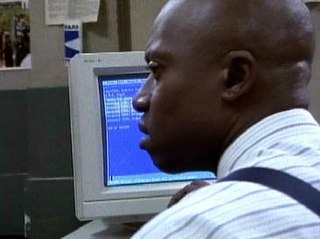
Francis Xavier "Frank" Pembleton is a fictional homicide detective on the television drama series Homicide: Life on the Street portrayed by Emmy Award–winning actor Andre Braugher. He is a primary character of the show through the first six seasons. Although the show featured an ensemble cast, Pembleton would become the fan favorite and is often identified by as the show's signature character. He is based on Baltimore Police Department Detective Harry Edgerton, who, like Pembleton, was an eccentric New York–born African American detective in the BPD homicide unit featured in David Simon's book Homicide: A Year on the Killing Streets. The character also appeared in the Law & Order episode "Charm City".

The first season of Homicide: Life on the Street, an American police procedural drama television series, originally aired in the United States on NBC between January 31 and March 31, 1993. The show was created by Paul Attanasio, with film director Barry Levinson and television writer and producer Tom Fontana serving as executive producers. Adapted from David Simon's 1991 non-fiction book Homicide: A Year on the Killing Streets, the season followed the fictional detectives of Baltimore Police Department homicide unit and the murder cases they investigate. The show was broadcast on Wednesdays at 9 p.m. EST, with the exception of the series premiere, which aired immediately after Super Bowl XXVII.
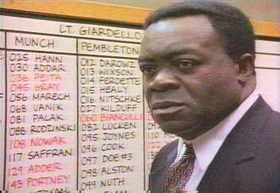
Alphonse Michael 'Gee' Giardello Sr. is a fictional character from the television drama Homicide: Life on the Street. The character was played by Yaphet Kotto. He is based on Baltimore Police Department Shift Lieutenant Gary D'Addario, a member of the BPD homicide unit described in David Simon's book Homicide: A Year on the Killing Streets which served as the inspiration for the series as a whole. The character also appeared in the Law & Order episode "Baby, It's You".
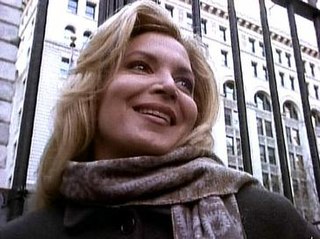
Detective Megan Russert is a fictional character on Homicide: Life on the Street played by Isabella Hofmann. At the time of her introduction in the premiere episode of the third season, she is a lieutenant who takes charge of the homicide unit's second shift after the previous commander's retirement. Later in the season, a vacancy opens up in the chain of command and she is promoted to captain on a trial basis, as a token of the city's commitment to diversity and equal opportunity.

The third season of Homicide: Life on the Street aired in the United States on the NBC television network from October 14, 1994, to May 5, 1995, and contained 20 episodes. It was the first full season of episodes. Beginning in the third season, Homicide was moved to Fridays at 10 p.m. EST, a timeslot the show would remain at until its cancellation in 1999.
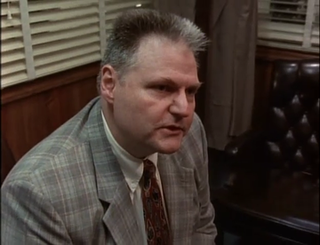
Roger Gaffney is a fictional police officer of the Baltimore Police Department on Homicide: Life on the Street. He was played by Walt MacPherson.

Stuart Gharty is a fictional character played by Peter Gerety in the television series Homicide: Life on the Street.

"Gone for Goode" is the first episode of the first season of the American police drama television series Homicide: Life on the Street. It originally aired on NBC in the United States on January 31, 1993, immediately following Super Bowl XXVII. The episode was written by series creator Paul Attanasio and directed by executive producer Barry Levinson. "Gone for Goode" introduced regular cast members Daniel Baldwin, Ned Beatty, Richard Belzer, Andre Braugher, Wendy Hughes, Clark Johnson, Yaphet Kotto, Melissa Leo, Jon Polito, and Kyle Secor.

"A Shot in the Dark" is the fourth episode of the first season of the American police drama television series Homicide: Life on the Street. It originally aired on NBC in the United States on February 24, 1993. The teleplay was written by Jorge Zamacona based on a story by executive producer Tom Fontana, and the episode was directed by Bruce Paltrow. In the episode, Crosetti focuses his investigation into the shooting of Officer Thormann on one suspect, while Lewis continues to investigate. Meanwhile, Pembleton and Bayliss pursue different leads in the murder case of 11-year-old Adena Watson.

"A Dog and Pony Show" is the sixth episode of the first season of the American police drama television series Homicide: Life on the Street. It originally aired on NBC in the United States on March 10, 1993. In the episode, Pembleton and Bayliss investigate the murder of a police dog, Crosetti helps his friend adjust after a serious injury, and Felton and Howard suspect a drug dealer for a brutal murder.
"And the Rockets' Dead Glare" is the seventh episode of the first season of the American police drama television series Homicide: Life on the Street. It originally aired on NBC in the United States on March 17, 1993. In the episode, Howard testifies in a murder trial, Pembleton is offered a promotion, and Lewis and Crosetti go to the Chinese Embassy in Washington, D.C. to investigate a political refugee's murder.

"Smoke Gets in Your Eyes" is the eighth episode of the first season of the American police drama television series Homicide: Life on the Street. It originally aired on NBC in the United States on March 24, 1993. In the episode, Howard and Bayliss attempt to quit smoking, Gee discovers secret asbestos removal in the squad room, and Munch and Bolander investigate the beating death of a 14-year-old boy. The episode was written by James Yoshimura and Tom Fontana, and was directed by Wayne Ewing, who doubled as director of photography.

"End Game" is the 14th episode of the third season of the American police drama television series Homicide: Life on the Street. It originally aired on NBC on February 10, 1995. The episode was written by Rogers Turrentine and directed by Lee Bonner. The episode continues a storyline about the shooting of Beau Felton, Kay Howard, and Stanley Bolander.
"Law & Disorder" is the 15th episode of the third season of the American police drama television series Homicide: Life on the Street. It originally aired on NBC on February 24, 1995. The episode was written by Bonnie Mark and Julie Martin and directed by John McNaughton. The episode concludes elements of a storyline about the shooting of Beau Felton, Kay Howard, and Stanley Bolander.
"Fallen Heroes" is a two-part episode that concludes the sixth season of the American police drama television series Homicide: Life on the Street. It comprises the 99th and 100th overall episodes of the series, and originally aired on NBC in the United States on May 1, 1998 and May 8, 1998.
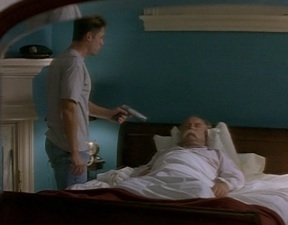
"See No Evil" is the second episode of the second season of the American police drama television series Homicide: Life on the Street, and the eleventh overall episode of the series. It originally aired on NBC in the United States on January 13, 1994. In the episode, Felton's friend kills his father in an assisted suicide, and Felton tries to convince Lewis to look the other way. In a subplot, Pembleton investigates what appears to be the police shooting of an unarmed suspect.
"Black and Blue" is the third episode of the second season of the American police drama television series Homicide: Life on the Street, and the twelfth overall episode of the series. It originally aired on NBC in the United States on January 20, 1994. In the episode, Pembleton aggressively investigates what he believes to be a police-related shooting. Amid pressure from Gee to pursue civilian suspects, Pembleton elicits a successful confession from an innocent man, leaving Gee feeling conflicted. Directed by Chris Menaul, the episode's teleplay was written by James Yoshimura based on a story by series executive producer Tom Fontana.
"Fire" is the season premiere of the fourth season of the American police drama television series Homicide: Life on the Street. It originally aired on NBC on October 20, 1995. The episode was written by Julie Martin and was directed by Tim Hunter. The two-part story centres on Pembleton and Bayliss' investigation into a pair of arson-related homicides, and introduces a new regular character, Arson Squad detective Mike Kellerman, who subsequently transfers to Homicide and partners with Det. Meldrick Lewis. This episode also flagged the permanent departure of regular characters Stanley Bolander and Beau Felton.
"Fire " is the second, concluding part of the two-part season premiere of the fourth season of the American police drama television series Homicide: Life on the Street. It originally aired on NBC on October 27, 1995. Both parts were written by Julie Martin ; Part 1 was directed by Tim Hunter, and Part 2 by Nick Gomez. This episode concludes the investigation of a pair of arson-related homicides, led by detectives Pembleton and Bayliss, with their Arson Squad colleague Det. Mike Kellerman.
References
- 1 2 3 Paeth, Greg (October 8, 1994). "TV highlights for the upcoming week". Scripps Howard News Service.
- 1 2 Bonko, Larry (October 8, 1994). ""NYPD," "Homicide" look to be arresting TV fare". The Virginian-Pilot . p. TV01.
- ↑ Kalat, David P. (1998). Homicide: Life on the Street: The Unofficial Companion. Los Angeles, California: Renaissance Books. p. 53. ISBN 1-58063-021-9.
- ↑ Shister, Gail (February 28, 1994). "Polito turns his back, and mouth, on 'Homicide' Actor leaves show with parting shots about its mediocrity". The Kansas City Star . p. D2.
- 1 2 3 Kalat, pp. 54–55
- 1 2 3 4 5 6 7 Pergament, Alan (October 13, 1994). "'Homicide's' gritty, witty script and superb cast are to die for". The Buffalo News . p. D6.
- ↑ Kalat, p. 88
- 1 2 3 4 5 Kalat, p. 146
- ↑ Kalat, p. 145
- ↑ Katat, p. 112
- ↑ McWilliams, Michael; McFarlin, Jim (October 6, 1994). "Monday, Oct. 10". USA Today .
- ↑ Williams, Scott (October 20, 1994). "Tuesday lineup puts ABC on top". South Florida Sun-Sentinel . p. 4E.